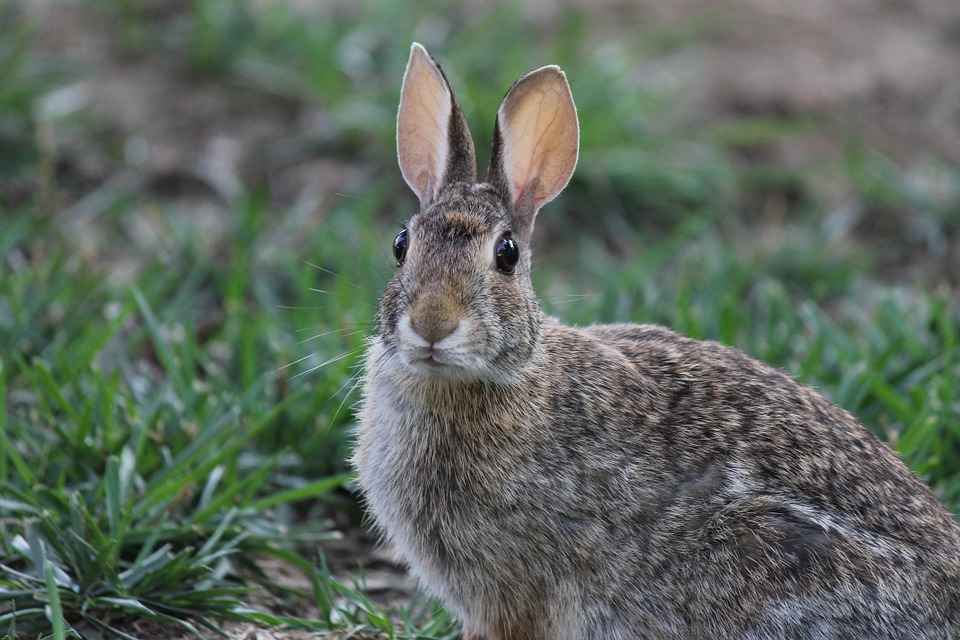This comprehensive guide delves into the world of rabbit-proofing your garden, offering practical advice and tested methods to protect your prized plants from these nibbling creatures. We'll explore everything from physical barriers and natural repellents to smart planting choices and even rabbit-proofing your plants.
Part 1: Understanding the Rabbit Problem

1.1. Why Rabbits are a Garden Pest
Rabbits, though adorable, can quickly transform your garden into a buffet. They possess a voracious appetite, often targeting young, tender growth and prized vegetables. While they may not always be destructive, their nibbling habits can leave plants disfigured and your garden looking unkempt.
1.2. Identifying the Signs of a Rabbit Problem
Before implementing any rabbit-deterring measures, it's essential to recognize the telltale signs of their presence. Look out for:
- Chewed stems and leaves: This is the most obvious sign, especially if the damage is in a distinctive diagonal pattern.
- Holes dug in the ground: Rabbits often dig burrows for shelter, especially in loose soil.
- Rabbit droppings: These are typically small, round pellets, often found in clusters.
- Footprints in soft soil: These are small, oval-shaped tracks, usually appearing in pairs.
- Gnawed bark on trees: Rabbits may also nibble on the bark of young trees, potentially causing damage.
Part 2: Physical Barriers: Keeping Rabbits Out

2.1. The Power of Fencing
Fencing is the most effective way to create a physical barrier that rabbits cannot penetrate. However, it's crucial to understand the nuances of rabbit behaviour and select the appropriate type of fencing.
2.1.1. Choosing the Right Fence
- Height: Rabbits are skilled jumpers, capable of clearing heights of up to 3 feet. Therefore, fences should be at least 3 feet tall, ideally with an inward slope at the top to discourage climbing.
- Material: Common materials include chicken wire, welded wire mesh, and plastic netting.
Chicken Wire: Affordable, but prone to bending and can be easily gnawed through.
Welded Wire Mesh: More durable, offers greater protection, but can be more expensive.
Plastic Netting: Lightweight and easy to install, but might not withstand strong winds or heavy objects.
- Durability: Robust posts and secure installation are critical to prevent rabbits from digging under or pushing the fence over. Use concrete footings for added stability.
- Bottom Protection: Extend the fence at least 6 inches below ground level to prevent rabbits from digging under it.
2.1.2. Fences for Specific Areas
- Vegetable Patches: A smaller, enclosed fence specifically for your vegetable garden is highly recommended.
- Flower Beds: For smaller areas, consider using a fence made from materials like bamboo stakes or metal stakes woven with netting.
- Trees: For protecting individual trees, wrap the trunk with wire mesh or plastic netting, extending at least 2 feet above the ground and 1 foot below.
2.2. Other Physical Barriers
- Mesh Covers: Covering plants with netting or plastic sheeting can create a temporary barrier, especially useful for smaller plants or during periods of high rabbit activity.
- Repellent Plants: Some plants naturally deter rabbits, such as lavender, garlic, and rue. Planting these around your garden perimeter can create a natural barrier.
- Commercial Rabbit Repellents: While not always effective, some commercial repellents contain ingredients like chilli pepper extract, garlic oil, or predator urine that can deter rabbits.
Part 3: Sensory Deterrents: Confusing Rabbits
3.1. Sounds and Smells
Rabbits have highly sensitive hearing and smell. Utilize these senses to deter them from your garden.
3.1.1. Motion-Activated Sprinklers
These sprinklers are triggered by movement, startling rabbits and discouraging them from entering your garden. Choose sprinklers with wide spray patterns and adjust the settings based on the size of your garden.
3.1.2. Ultrasonic Devices
These emit high-frequency sounds that are irritating to rabbits but inaudible to humans. However, their effectiveness can vary based on the density of vegetation in your garden. Consider using multiple devices for broader coverage.
3.1.3. Strong Smells
Certain scents, like predator urine, can deter rabbits. Use commercially available predator urine spray or plant strong-smelling herbs like garlic, rosemary, and mint. Remember that these smells may fade over time, so regular reapplication is necessary.
Part 4: Planting for Resistance: Rabbit-Proof Plants
4.1. Understanding Rabbit Preferences
Rabbits have a distinct preference for certain plants, often choosing those with tender leaves and succulent stems.
- Favourite Foods: Lettuce, cabbage, carrots, tomatoes, beans, and leafy greens are high on their list of preferred foods.
- Less Preferred: Herbs, flowers, and some vegetables like onions, garlic, chives, kale, and spinach are less appealing, but not always off-limits.
4.2. Choosing Rabbit-Resistant Plants
- Herbs: Lavender, mint, rosemary, sage, thyme, oregano
- Flowers: Marigolds, zinnias, sunflowers, daffodils, tulips, alliums
- Vegetables: Onions, garlic, chives, kale, spinach, Brussels sprouts, collard greens
- Trees and Shrubs: Hawthorn, holly, rosemary, laurel, rhododendron, yew
4.3. Planting Strategies
- Companion Planting: Mixing rabbit-resistant plants with those more susceptible can provide a protective barrier. For example, planting garlic near tomatoes can deter rabbits from nibbling on the tomatoes.
- Strategic Placement: Plant rabbit-resistant species around the perimeter of your garden to create a natural fence, discouraging rabbits from venturing inwards.
Part 5: Effective DIY Repellents
5.1. Natural Options: Safe and Eco-Friendly
- Garlic Spray: Mix 4-5 crushed garlic cloves with 1 cup of water and let it steep for a few days. Strain the mixture and spray it on your plants, especially around vulnerable stems and leaves.
- Pepper Spray: Combine 1 tablespoon of hot pepper flakes with 1 cup of water and let it steep for 24 hours. Strain the mixture and spray it on plants. The spiciness can deter rabbits.
- Citrus Peels: Scatter citrus peels around your garden, especially near areas where rabbits frequent. The strong scent can deter them.
- Blood Meal: Sprinkle blood meal around the base of plants, particularly those susceptible to rabbit damage. Its strong scent can deter rabbits.
5.2. Homemade Predators: Frightening the Rabbits
- Fake Predators: Place fake owls, hawks, or snakes throughout your garden to deter rabbits. Change their positions regularly to keep rabbits guessing.
- Motion-Activated Sounds: Use a motion-activated device that emits loud noises like animal distress calls to scare rabbits away.
- Human Hair: While not scientifically proven, some gardeners claim that scattering human hair around their gardens deters rabbits.
Part 6: Managing the Rabbit Problem: Long-Term Solutions
6.1. Controlling the Rabbit Population
- Habitat Management: Remove sources of food and shelter for rabbits, such as overgrown vegetation, piles of debris, and areas with dense undergrowth.
- Natural Predators: Encourage natural predators like owls, hawks, and foxes into your garden. Provide suitable nesting sites or install bird feeders to attract these predators.
- Trapping and Relocation: If all else fails, consider humane trapping and relocation, but ensure it is legal in your area and done responsibly.
6.2. Maintaining Your Protection
- Regular Inspection: Check your fences and barriers for damage regularly. Rabbits are notorious for finding weaknesses and exploiting them.
- Repairs and Maintenance: Repair any gaps or holes in your barriers promptly. Ensure the fence remains securely fastened to the posts.
- Ongoing Deterrent Application: Continue to apply natural repellents or predator urine spray regularly. The effectiveness of these deterrents can diminish over time.
Part 7: FAQs: Common Rabbit-Related Questions
7.1. What is the best time to deter rabbits?
Rabbits are most active in the early morning and late evening, so it's crucial to have deterrents in place during these times. This is when they are most likely to venture out for food and forage.
7.2. Can I use human hair as a repellent?
While it's a popular myth, there's no scientific evidence that human hair effectively deters rabbits. While it might offer a temporary deterrent, it's not a reliable solution.
7.3. What if my neighbour has a rabbit problem?
If your neighbour has a rabbit problem, their rabbits may be venturing into your garden. It's a good idea to have a conversation with them about rabbit-deterring measures. Coordinated efforts can be more effective.
7.4. Are there any plants that rabbits absolutely won't eat?
While some plants are less appealing to rabbits, there's no guarantee that they won't nibble on them. Rabbits are opportunistic feeders and may experiment with different plants if their preferred choices are unavailable.
7.5. Can I use commercial rabbit repellent on edible plants?
It's essential to read the label carefully before using any commercial repellent on edible plants. Ensure it's safe for consumption and that there is a suitable waiting period before harvesting any produce.
7.6. What if my garden is overrun with rabbits?
If your garden is overrun with rabbits, contacting a professional pest control service might be the best course of action. They can assess the situation and recommend appropriate control measures.
7.7. What are some common mistakes people make when trying to deter rabbits?
Using ineffective deterrents: Some popular methods, like soap bars or mothballs, have no proven effect on rabbits.
Not securing fences properly: Fences that are poorly installed or have gaps can be easily breached by rabbits.
Neglecting maintenance: Regularly checking and repairing barriers is essential to ensure they remain effective.
Relying on one solution: Combining multiple methods like physical barriers, repellents, and natural predators can offer a more comprehensive solution.
Everyone is watching
-

Do Rabbits Lay Eggs? (The Surprising Truth)
OTHER TYPES OF PETSThis article will unravel the common misconception that rabbits lay eggs, exploring the fascinating world of r...
-

What's a Group of Rabbits Called? (A Comprehensive Guide)
OTHER TYPES OF PETSThis article delves into the fascinating world of rabbits, exploring the various terms used to describe a grou...
-

Can Rabbits Eat Grapes? A Guide to Safe Rabbit Treats
OTHER TYPES OF PETSThis comprehensive guide will explore the safety and suitability of grapes for rabbits, providing detailed inf...
-

Predators That Hunt Rabbits: A Guide to Natural Enemies
OTHER TYPES OF PETSI've always been fascinated by the circle of life, that delicate dance between predator and prey. Growing up ...
-

Are Rabbits Nocturnal Animals?
OTHER TYPES OF PETSThe question of whether rabbits are nocturnal animals is a fascinating one, with a surprisingly complex answer...
